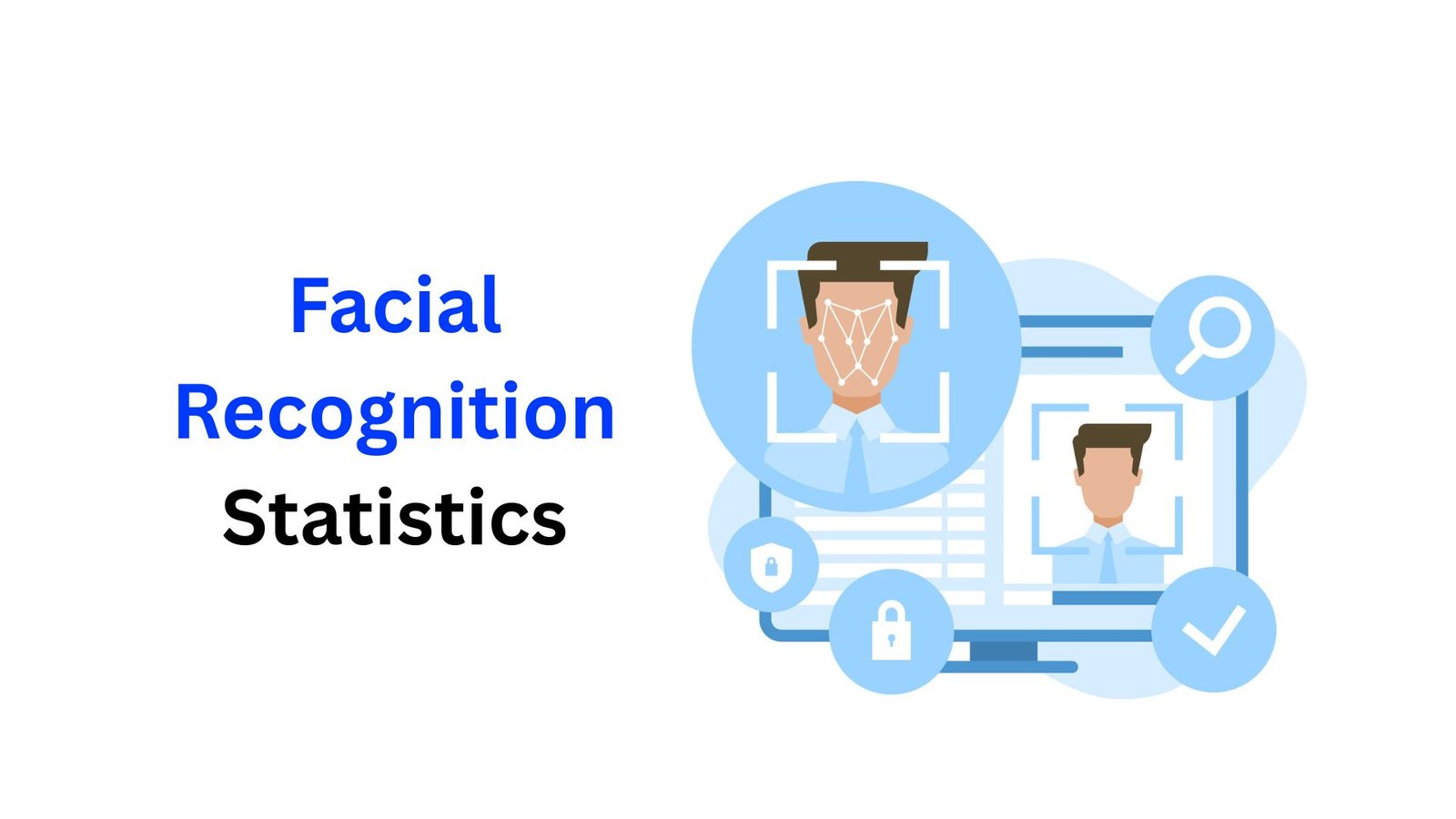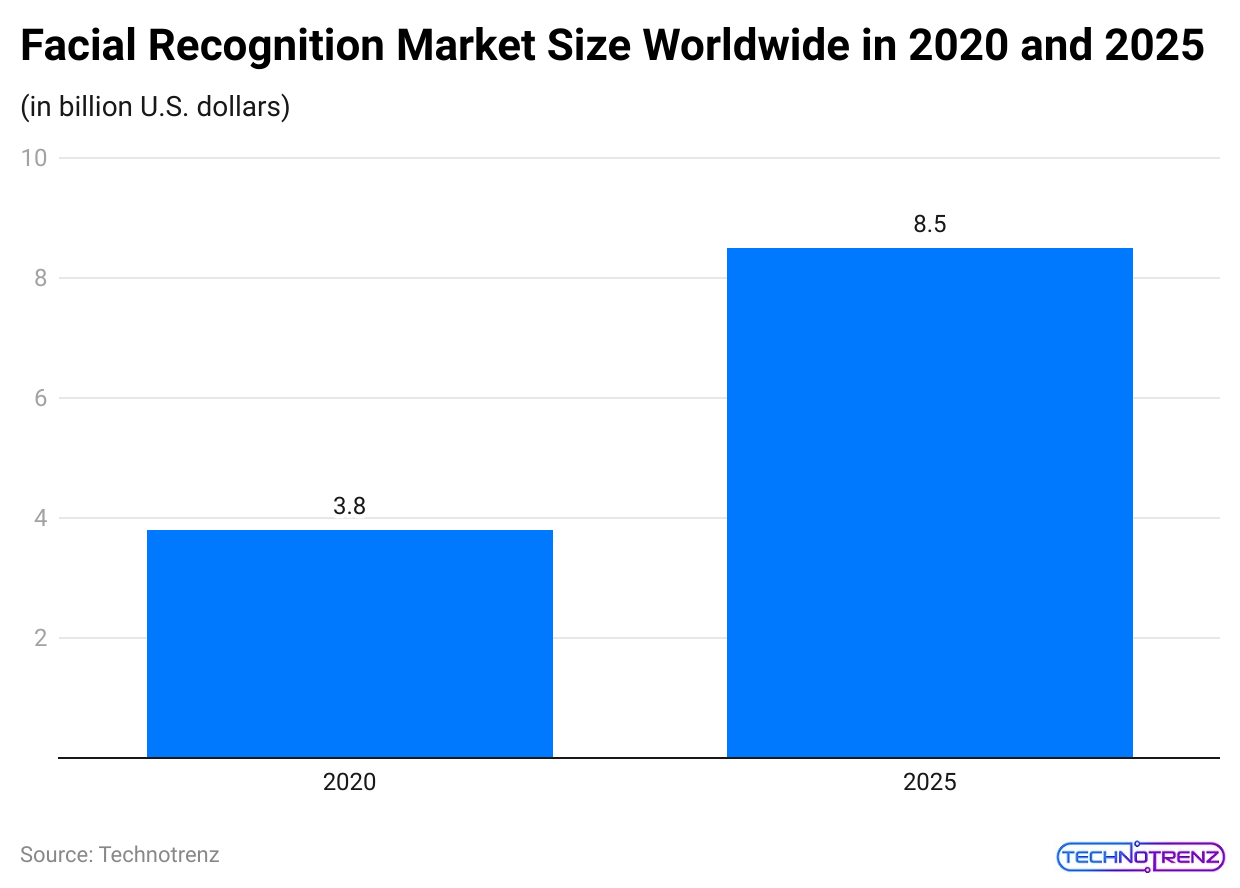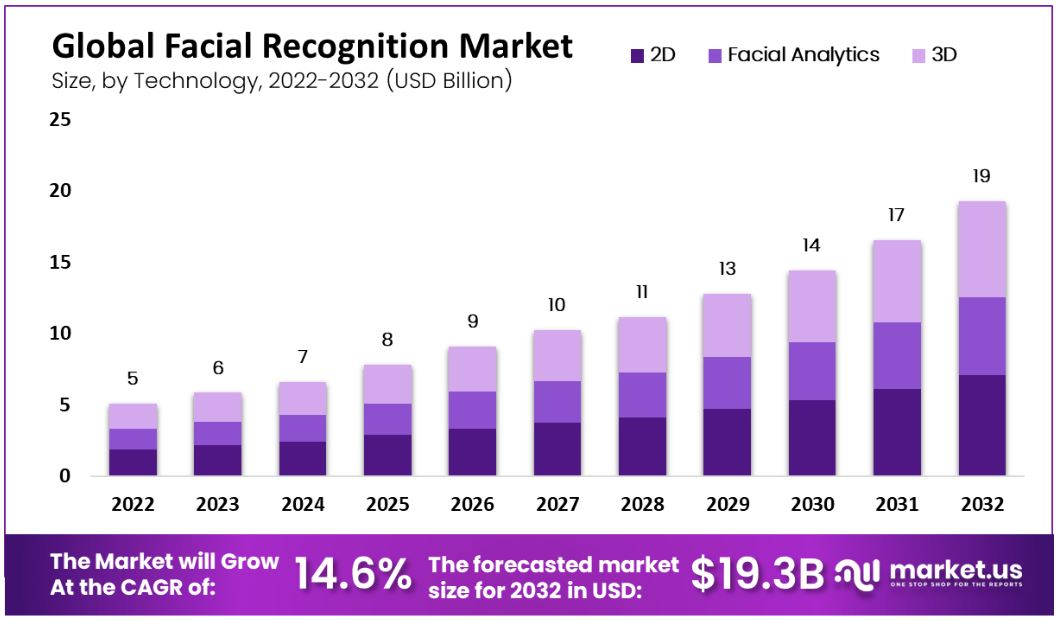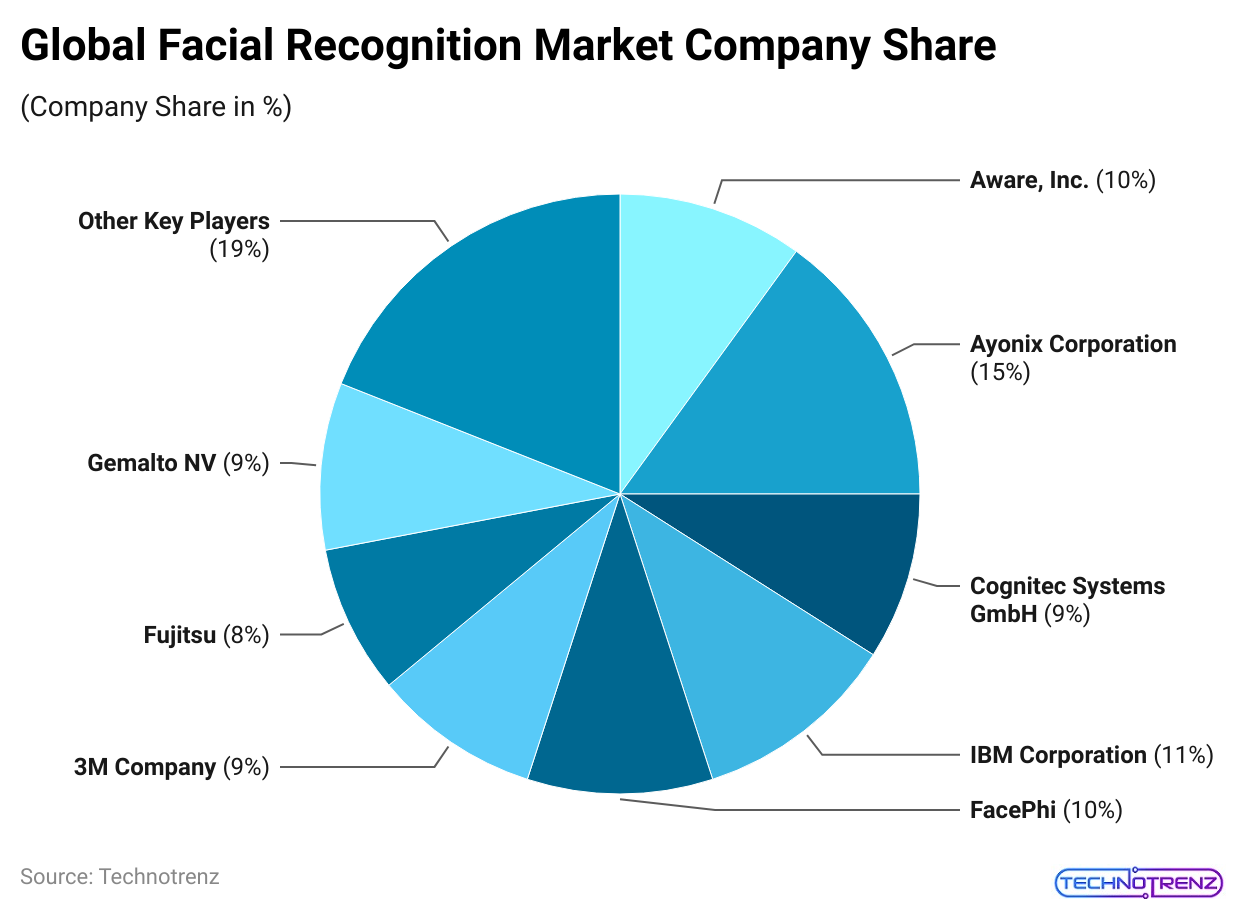Facial Recognition Statistics By Market Size, Security And Facts (2025)
Updated · Oct 08, 2025

WHAT WE HAVE ON THIS PAGE
- Introduction
- Editor’s Selection
- Face Recognition Market Size
- Facial Recognition Market Size By Technology
- Facial Recognition – Introduction By Countries
- Statistics On Facial Recognition Technology Usage
- Facial Recognition Market Key Players
- Facial Recognition In Business Statistics
- Face ID And Biometrics Evolution
- Privacy Regulations And Landscape of Compliance
- Facial Recognition And Security Statistics
- Conclusion
Introduction
Facial Recognition Statistics: The technology of facial recognition has thus quickly germinated from a futuristic innovation to a fairly standard tool that shapes industries, governments, and everyday life. Touting use areas of security, retail, health care, travel, and money, the growth is simply overwhelming and highly debated. On one side, businesses use it to increase efficiency and prevent fraud; on the other, consumers use it for convenience to unlock devices or to verify their identities.
Opposing it, privacy concerns and stringent regulations paint another agitating picture. The value of the market just goes up as global adoption moves visibly faster, where facial recognition finds every space from airports to ATMs to hotel check-ins-further proof that the world now considers this technology essential to ensure security, convenience, and tech evolution at the present. This article will show the latest facial recognition statistics.
Editor’s Selection
- The Global Facial Recognition Market is forecasted to grow from USD 3.8Billion in 2020 to USD 8.5Billion by 2025.
- Market expected to reach USD 19Billion by 2032 and grow at a 14% CAGR.
- Facial recognition is listed as in large-scale use by 70% of governments worldwide.
- 97% of U.S. airports are expected to adopt facial recognition by late 2023.
- China, Russia, the UAE, Japan, India, and the US are among the top adopters worldwide.
- Automotive, healthcare, telecom, retail, and law enforcement are sectoral growth drivers.
- 68% of people use FRT to unlock devices, whereas 42% use it for banking services.
- About 83% of the U.S. customers are willing to back businesses that apply FRT.
- Ayonix Corporation is in the leadership position, having a 15% market share. In second and third places come IBM and Aware, respectively.
Face Recognition Market Size
 (Reference: statista.com)
(Reference: statista.com)
- As per a Statista report, facial recognition statistics show that in 2020, the global facial recognition market had a value of 3.8 billion U.S. dollars.
- The so-called rapid growth in the building and design industry is increasing faster, with a projection to more than double in just about five years.
- This industry is forecasted to reach US$8.5 billion by 2025, showcasing the progressive adoption and implementation of facial recognition technology commercialized in sectors like security, retail, healthcare, and consumer electronics.
- The rapid construction equates to the deployment of new systems for identification, surveillance, and authentication promoted by technological advancement and security-related issues.
Facial Recognition Market Size By Technology

(Reference: scoop.market.us)
- As per Market.us, facial recognition statistics show that valued at USD 5 billion in 2022, the facial recognition technology market is expected to expand at a CAGR of 14% and to reach USD 19 billion by 2032.
- The market, starting from USD 5 billion in 2022, rose to USD 6 billion in 2023 and USD 7 billion in 2024 due to increasing adoption.
- Revenues further rose to USD 8 billion in 2025 and USD 9 billion in 2026.
- The strong upward trend will continue with revenues hitting USD 10 billion in 2027, USD 11 billion in 2028, and USD 13 billion in 2029.
- This technology can perform with precision above 99% in highly controlled conditions.
- Still, real-life applications impacting conditions or changes in appearance might generate a low-accuracy rate.
- Around 70% of governments worldwide currently undertake facial recognition at a massive scale.
- Apple claims Face ID is a one in a million chance for a random person to unlock, while Facebook’s DeepFace lags with 97% accuracy for face matching.
- By late 2023, facial recognition shall be adopted by 97% of the U.S. airports, a technology that was first credited for assisting in arresting at Washington Dulles International Airport in August 2018.
Facial Recognition – Introduction By Countries
China
- China is ranked fifth among 40 entries in facial recognition adoption, with the bizarre standing of the country being that of a world leader in this technology.
- The FRT is employed by the government and law enforcement agencies in the purview of intrusive surveillance.
- To cite a few widely publicized instances, authorities in Suzhou used facial recognition to publicly shame seven individuals for having worn pajamas outdoors and posted their images on WeChat.
- In yet another strange example, a park used facial recognition technology to prevent people from stealing rolls of toilet paper.
Russia
- Russia is ranked ninth out of 40.
- Facial recognition is gradually being embraced across many different industries, much like in other higher-ranked countries.
- It is an indicator of this country’s increasing dependence on this technology for a great multitude of varied applications.
United Arab Emirates (UAE)
- Ranked 10th, the UAE is pushing harder on FRT utilization. Speeding up processes and preventing fraud are its two main objectives.
- The scope of use is very broad, from accessing government services to tracking school attendance, keeping the technology at the heart of everyday operations.
Japan
- Japan ranks 12th out of 40. In Japan, FRT is used in several areas, with law enforcement being perhaps the most significant application area.
- The police in Japan track alleged offenders by linking FRT to crime-related social media accounts.
- The National Public Safety Commission maintains a face database of 10 million images, which can be used alongside FRT by the police in their investigations.
India
- India is also ranked 12th out of 40 and is actively implementing facial recognition systems.
- At present, 16 such systems operate under various central and state governments, and another 17 such systems are being developed, indicating rapid adoption of these technologies.
Australia
- Australia stands at 13th place out of 40. Law enforcement is employing the controversial Clearview AI, which uses images collected from social media to build its database.
- After some backlash from the public, Victoria police separated themselves from Clearview, stressing the ethical dilemma of FRT use.
United States
- The U.S. is ranked 18th out of 40. While it is clear that facial recognition adoption continues across numerous domains, there is no evidence, however, of its deployment in public buses, suggesting a segregated situation compared with a few other countries.
By Types of Facial Recognition
- Adoption of facial recognition systems is increasing rapidly in industries. The automotive and transport sector expects a growth to the tune of USD 11.82 billion between 2023 and 2028, at a rate of 22.2% per annum.
- The market in the healthcare sector is estimated to grow from USD 6.01 billion in 2024 to USD 17.84 billion by 2031, registering a CAGR of 16.8%.
- Telecom and IT sectors expect growth at a CAGR of 17.87% from 2024 to 2032.
- Retail and e-commerce expect growth from USD 6.3 billion in 2023 to USD 13.4 billion in 2028 at a CAGR of 16.3%.
- Security and law enforcement sectors will also grow from USD 6.61 billion in 2024 to USD 14 billion in 2029, recording a 16.20% CAGR.
- The media and entertainment sector is expected to grow at a 16.6% rate.
By Applications of Facial Recognition
- Facial recognition has achieved its high level of accuracy, 99.5% in the best case. In 2024, 68% of people used it to unlock their personal devices, that is, phones or laptops.
- Some 51% used FRT to sign into phone apps, including those for healthcare or ticketing, and 42% signed in for banking or financial services.
- Forensic facial recognition is highly regarded in public opinion: 78% feel police work is accelerated by it; 74% consider it useful in crime solving.
Statistics On Facial Recognition Technology Usage
- Being a crucial stakeholder, retail stores appear to have massively adopted FRT: 53% of stores use it for identity verification of account holders at checkout to authorize payments.
- 51% of apartment buildings use it to monitor entry and exit; 30% of companies use it as an automated system for employee attendance.
- In contrast, social media platforms have an auto-tagging accuracy of only 19%.
- Awareness is now increasing: 60% of adults are aware that organizations utilize FRT at the workplace, but 70% of U.S. adults do not approve of FRT being used for employee emotion analysis.
Acceptance-By Industry
- As of 2024, Americans generally support facial recognition for uses tied to safety.
- By acceptance, it ranks highest in airports (55%), banks (54%), and medical offices (53%).
- Slightly less acceptance by broad adoption is seen across workplaces and services: offices (39%), hotels (30%), sports stadiums (29%), public transportation (28%), retail and grocery stores (26%), and restaurants (23%).
- This could be indicative of a split between security high grounds and everyday trade apprehension.
Facial Recognition Market Key Players

(Reference: scoop.market.us)
- The Facial Recognition Technology market is shared by several large companies, each of which occupies a good chunk of the market.
- Ayonix Corporation has the largest share at 15%, followed by IBM Corporation with 11% and Aware, Inc. with 10%.
- FacePhi and Gemalto NV also have fairly strong presences, with one holding a market share of 10% and the other 9%.
- Together, Cognitec Systems GmbH, 3M Company, and Fujitsu collectively possess 26% of the market, with individual shares of 9%, 9%, and 8%.
- The remaining 19% is shared by a number of implementations in the industry, thus again proving that the market remains competitive and diverse.
Facial Recognition In Business Statistics
- Facial recognition in business is growing into a vital tool for companies and government organizations alike—protecting sensitive data on the one hand and raising privacy issues on the other.
- The technology makes it possible to scan a person’s face in real-time and track any changes in appearance for security that would otherwise have been impossible.
- Reports reveal that 32% of consumers in certain markets are amenable to private companies using facial recognition.
- About 30% of homeowners support the idea of installing security cameras at entrances, while 34% oppose it.
- Hotels providing facial recognition are estimated to grow by 74% by 2025, offering a safer service.
- Similarly, in retail, facial recognition may reduce security incidents by 91%.
- A Spanish study revealed that 70% of ATM users would rather use facial recognition than enter a PIN for withdrawals.
- In the hotel industry, 62% of customers would be willing to adopt this technology for enhanced security and better experience, and 41% choose hotels offering such high security.
- The technology works at blazing speed; it identifies someone in about two seconds. Overall, 83% of U.S. citizens support businesses that employ facial recognition.
Face ID And Biometrics Evolution
- Rapid advancements characterize biometric authentication, creating an entirely new way of securing devices and accessing systems.
- Apple Face ID presents a significant shift toward securing something more possessive than a password, with less than a one-in-a-million chance of spoofing.
- The success of Face ID has created industry standards and driven adoption.
- The usage of biometric authentication across sectors is further expanding, with the projections showing that 66% of smartphone owners will be using biometrics, up from 41%.
- In 2023, the percentage for facial recognition stood at almost 30%, whereas in 2019 it was merely 11%.
- On its part, voice-recognition picked up to a modest 20%.
- Access from everywhere is paramount for consumers as they want convenience, though comfort levels vary across age groups.
- In workplaces, biometrics predominate, with facial analytics being used in 68% of Fortune 500 companies and 22 million check-ins recorded daily.
- 22 million check-ins are being recorded daily! Younger working-age groups tend to show higher acceptance, while generational differences persist.
- Thus, another selling point for biometrics being considered the future for access control is touchless authentication, along with other benefits linked to integration with existing systems regarding scalability, security, and compliance.
Privacy Regulations And Landscape of Compliance
- The United States is the land of no universal rules on facial recognition technology, restricting its use by some proposals like the Facial Recognition and Biometric Technology Moratorium Act (H.R. 378).
- The regulation and compliance landscape on facial recognition technologies is getting more complex as laws continue to evolve.
- Implementation varies by agency, with organizations such as the FBI, U.S. Marshals, and Department of Homeland Security using it for security and border control, while other departments like Housing and Urban Development apply it in public housing surveillance.
- At the state level, Illinois’ Biometric Information Privacy Act (BIPA) stands out as the most important, requiring written consent for the collection of biological data and permitting people to sue for damages ranging from US$1,000 to US$5,000 per violation, even without any actual damage.
- Some states have followed with their own versions: Maryland limits its use to serious crimes, and Utah and Montana require a warrant, while Connecticut has its Attorney General enforce compliance.
- The number of states with restrictions, twenty-fifteen today, stands in stark contrast to the lone state in 2017.
- Globally, the GDPR and the upcoming AI Act hence exert a great deal of influence: imposing limitations on the use of data, the creation of databases, and inter- and intra-national transfers of data.
- These have already rendered 40% of projects delayed by compliance reviews.
- In general, privacy-by-design is becoming a worldwide norm, biometry-specific laws are coming into existence, and nations are cooperating increasingly on privacy standards.
- For multinationals, these new rules increase the cost of compliance and impart changes into industrial applications of facial recognition.
Facial Recognition And Security Statistics
- There has been mixed acceptance of facial recognition technologies among differing age groups, with adults over 30 showing a greater degree of acceptance than those between 18 and 29 years of age.
- 56% of U.S. residents believe the government assesses threats in public areas, whereas only 1% believe it should use more surveillance cameras.
- The use of facial recognition at U.S. airports began in 2019, marking the early adoption by institutions.
- There is also 59.4% support by Americans for police using facial recognition to track and identify suspects, highlighting solid public support for law enforcement use.
Conclusion
Facial Recognition Statistics: Facial recognition technology exemplifies how newer innovations address emerging needs. Unlike a static solution, it only improves with flexibility and security, from business to law enforcement. From the point of view of monitoring and identification, the technology offers enhanced protection to the organization while assisting in the gradual elimination of security threats as the technology itself advances.
There can never be a finish to this, and the enhancements will make day-to-day functioning more efficient, reliable, and safer.
Sources

After graduating in Electrical Engineering, Maitrayee moved into writing after working in various technical roles. She specializes in technology and Artificial Intelligence and has worked as an Academic Research Analyst and Freelance Writer, focusing on education and healthcare in Australia. Writing and painting have been her passions since childhood, which led her to become a full-time writer. Maitrayee also runs a cooking YouTube channel.










